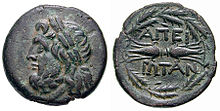Thesprotians

The Thesprotians (
Geography
Tribe
According to Strabo, the Thesprotians (along with the
Subtribes
The Thesprotians were divided into many subtribes that included the Elopes, Graeci, Kassopaeoi, Dryopes, Dodonians (Greek: Δωδωναίοι), Aegestaeoi, Eleaeoi, Elinoi, Ephyroi, Ikadotoi, Kartatoi, Kestrinoi, Klauthrioi, Kropioi, Larissaeoi, Onopernoi, Opatoi, Tiaeoi, Torydaeoi, Fanoteis, Farganaeoi,
Mythology
According to the
History

- Allied with Corinth in the 5th century BC.
- Allied with Athens and Molossis, 415–404 BC.
- Occupation of Kassopaea, Dodona, east Thesprotia by Molossians 400 BC.
- The Thesprotian League, middle 4th century BC.
- Allied with Macedonia, 343–300 BC.
- Part of the League of Molossis, 300 BC.
- Part of the Epirote League, included Chaonians and Molossians, 220–167 BC.
- Assigned as a district of Macedonia within Rome, 148–27 BC.
- Assigned as a district of Achaeawithin the Roman Empire from 27 BC.
List of Thesprotians
- Queen Kallidike, wife of Odysseus.
- King Aidoneus of Ephyra, husband of Persephone.
- Poionos: Admatos; Thesprotoi: Petoas, Simakos; Skepas, Aristodamos from Cassopea; Dioszotos from
- Alexandros prostates, mid-4th century BC.[19]
- Xenarchos son of Xenon from Cassopea (tomb stele), c. 310 BC.[20]
- Gallithos son of Xenon from Cassopea (tomb stele), c. 275 BC.[21]
- Sokratis daughter of Sotion from Boucheta (tomb stele), c. 250 BC.[22]
- Xenias of Cassopea
- Alkimos (son of Nikandros)
- Eucharon, Eunostidas proxenoi in Thermos (Aetolia), late 3rd century – early 2nd century BC.[25]
- Milon (son of Sosandros) honoured by Koinon of Epirotes, late 3rd century BC.[26]
- Opatos dedicated to Zeus Bouleus in Dodona, c. 215–210 BC.[27]
- Simakos (son of Phalakrion) 2nd century BC Pancratiast, Epidauria (fined 1000 staters, along with other two athletes).[28]
- Demetrios (son of Machatas) dedicated to Apollon at Ptolemaic city commander of Kourion.[30]
- Alkemachos (son of Charops) Diaulos (~400-metre race) Panathenaics, 190/189 BC, nephew of Demetrios.[30]
- Echenika daughter of Menedamos and Aristokrateia from Kassopa, wife of Lysixenos (tomb stele), 2nd century BC.[31]
See also
- Chaonia
- Necromanteion
- Ancient Thesprotia
References
Citations
- ^ "Epirus". Encyclopædia Britannica. Retrieved 1 July 2013.
- ^ Hammond 1994, pp. 430, 434; Hammond 1982, p. 284; Wilkes 1995, p. 104.
- ^ Errington 1990, p. 43.
- ^ See book 19
- ^ Hansen & Nielsen 2004, p. 347.
- ^ Hansen & Nielsen 2004, p. 346.
- ^ a b Hansen & Nielsen 2004, p. 342.
- ^ Hansen & Nielsen 2004, p. 340.
- ^ Liddell & Scott 1889: πελιγᾶνες.
- ^ Hammond 1994, p. 437
- ^ "Regions : Northern Greece (IG X) : Epeiros, Illyria, and Dalmatia : Epeiros". Archived from the original on 2015-07-23.
- ^ Hornblower 2002, p. 199.
- ^ Horsley 1987, p. 243; Hornblower 2002, p. 199.
- ^ Hammond 1994, p. 431–434.
- ^ Hammond 1986, p. 75.
- ^ Telegony, Fragment 1 (from Proclus, Chrestomathia 2).
- ^ IG IV²,1 95 col I.1 Line 25
- ^ Brock & Hodkinson 2000, p. 247; Hansen & Nielsen 2004, p. 348.
- ^ Cabanes, L'Épire 576,49.
- ^ Thess. Mnemeia, 286,72.
- ^ Thess. Mnemeia, 288,74.
- ^ Thess. Mnemeia, 320,103.
- ^ IG IX,1² 2:243.
- ^ FD III 2:83.
- ^ IG IX,1² 1:31 line 47.
- ^ Cabanes, L'Épire 547,17.
- ^ Cabanes, L'Épire 548,18.
- ^ Miller 2004, p. 74; IG IV²,1 99, II.
- ^ I.Kourion 42[1]
- ^ a b Habicht & Stevenson 2006, p. 89.
- ^ Acarnania - IG IX,1² 2:312, a.
Sources
- Brock, Roger; Hodkinson, Stephen (2000). Alternatives to Athens: Varieties of Political Organization. Oxford: Oxford University Press. ISBN 0-19-815220-5.
- Errington, Robert Malcolm (1990). A History of Macedonia. Berkeley, CA: University of California Press. ISBN 0-520-06319-8.
- Habicht, Christian; Stevenson, Peregrine (2006). The Hellenistic Monarchies: Selected Papers. Ann Arbor, MI: University of Michigan Press. ISBN 0-472-11109-4.
- Hammond, Nicholas Geoffrey Lemprière (1994). "CHAPTER 9d. ILLYRIANS AND NORTH-WEST GREEKS". In Lewis, David Malcolm; Boardman, John; Hornblower, Simon; Ostwald, M. (eds.). The Cambridge Ancient History: The Fourth Century B.C. Vol. VI. Cambridge: Cambridge University Press. pp. 422–443. ISBN 0-521-23348-8.
- Hammond, Nicholas Geoffrey Lemprière (1982). "CHAPTER 40 ILLYRIS, EPIRUS AND MACEDONIA". In Boardman, John; Hammond, Nicholas Geoffrey Lemprière (eds.). The Cambridge Ancient History: The Expansion of the Greek World, Eighth to Sixth Centuries B.C. Vol. III, Part 3 (2nd ed.). Cambridge: Cambridge University Press. pp. 261–285. ISBN 0-521-23447-6.
- Hammond, Nicholas Geoffrey Lemprière (1986). A History of Greece to 322 B.C. Oxford: Clarendon Press. ISBN 0-19-873096-9.
- Hansen, Mogens Herman; Nielsen, Thomas Heine (2004). An Inventory of Archaic and Classical Poleis. Oxford: Oxford University Press. ISBN 0-19-814099-1.
- Hornblower, Simon (2002). The Greek World, 479–323 BC. New York and London: Routledge. ISBN 0-415-16326-9.
- Horsley, G. H. R. (1987). New Documents Illustrating Early Christianity: A Review of the Greek Inscriptions and Papyri Published in 1979. Grand Rapids, MI: Wm. B. Eerdmans Publishing. ISBN 0-85837-599-0.
- Liddell, Henry George; Scott, Robert (1889). An Intermediate Greek-English Lexicon. Oxford: Clarendon Press.
- Miller, Stephen Gaylord (2004). Arete: Greek Sports from Ancient Sources. Berkeley and Los Angeles, CA: University of California Press. ISBN 0-520-24154-1.
- Wilkes, John (1995) [1992]. The Illyrians. Oxford: Blackwell Publishers Limited. ISBN 0-631-19807-5.
